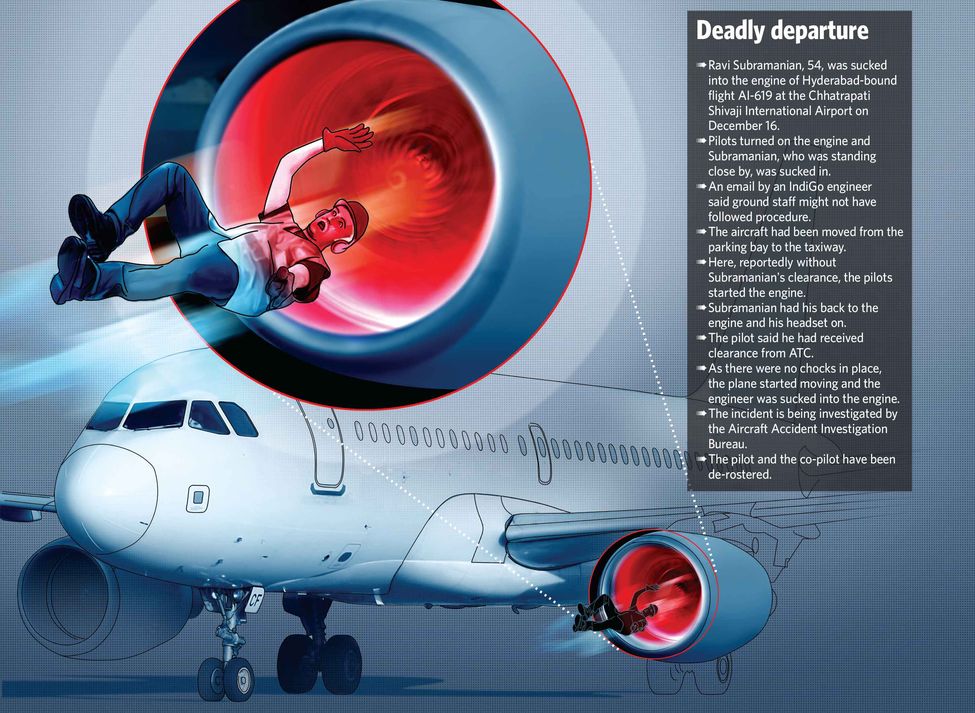In 2006, an airline technician died when he was sucked into the right engine of a Continental Airlines flight at the El Paso International Airport in Texas, US. A video of the gruesome accident is often circulated among young trainees at Indian carriers to demonstrate how the slightest slack can result in death.
In what must be only the second such recorded accident in history, 54-year-old Ravi Subramanian, an Air India service engineer, was sucked into an aircraft's engine at the Chhatrapati Shivaji International Airport in Mumbai on December 16. The Hyderabad-bound AI-619 flight moved from parking bay 28L to the taxiway, where the pilots turned on the engine, and Subramanian, who was standing close by, was sucked in and killed.
Air India chairman and managing director Ashwani Lohani expressed deep regrets and said the accident occurred “during pushback [moving the aircraft from passenger terminal to taxiway or runway] of flight AI-619”. He announced an ex gratia payment of Rs5 lakh to Subramanian's family and offered a job to one of his relatives. The pilot and the co-pilot have been de-rostered, and the Aircraft Accident Investigation Bureau, a division of the civil aviation ministry, is investigating the case.
Experts believe the accident to be a sure case of human error. “There are several possibilities,” said aviation safety expert Mohan Ranganathan. “The ground engineer may have given the clearance before ensuring that everything was clear. The pilot may have increased the thrust on the engine before getting ground clearance or clear ATC (air traffic control) instructions.” He said the auxiliary power unit of the aircraft, which is a small jet engine placed under the tail and used to start the larger jet engines, was not working. “[I] understand the co-pilot was a trainee and, if that was true, the training captain should have handled the engine start himself, as a start with an unserviceable APU is not normal, and a trainee may not have been able to handle it,” he said. In the absence of a functioning APU, the pilot may have done a cross-bleed start, in which bleed air from one engine is used to start the other one. “You cannot do a cross-bleed start during pushback,” Ranganathan said. Even after the pushback is over, a cross-bleed start can be done only if a number of conditions are fulfilled. Parking brakes must be set, all ground equipment, including the tow bar, must be removed and the ground engineer must give clearance for a cross-bleed start. The pilot, Captain A.G. Sharma, told the police that he started the engine after the ATC gave him clearance.
An email circulated by IndiGo maintenance engineer Pradeep Singh Rawat, which was leaked, noted that ground staff may not have followed standard operating procedure. Chocks, or wedges, must be put in place to hold the aircraft's wheels. These were missing. The email said a clearance signal was not taken from the engineer before taking out the plane towards the runway. On Subramanian's instruction, helper E.T. Shinde removed the tow bar while the former had his back to the engine and his headset on. This was when the pilot received clearance from the ATC. As there were no chocks in place, the plane started moving and the engineer was sucked into the engine, wrote Rawat, who is believed to have received these details from Subramanian's colleagues.
The Indian Commercial Pilots Association, a union of Air India pilots, has been on the defensive. Said general secretary T. Praveen Keerthi: “The black box and the CVR (cockpit voice recorder) have been taken and only after listening to the CVR and decoding the FDR (flight data recorder) will we know exactly what has transpired. It will not be fair to comment on anything before that.”
Subramanian's family, however, is satisfied with Air India's response. “Whatever they could have done in such a situation, they have done,” said a relative. “It was an accident, after all.” The family has not decided on whether it will accept the compensation or take legal recourse.






